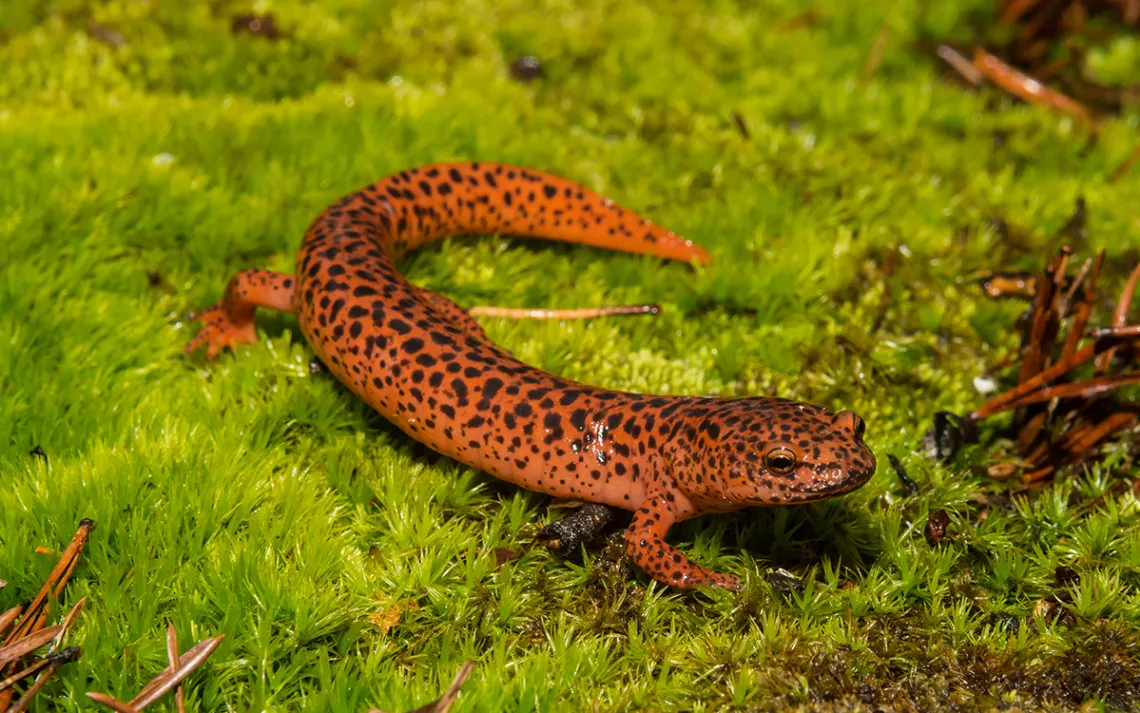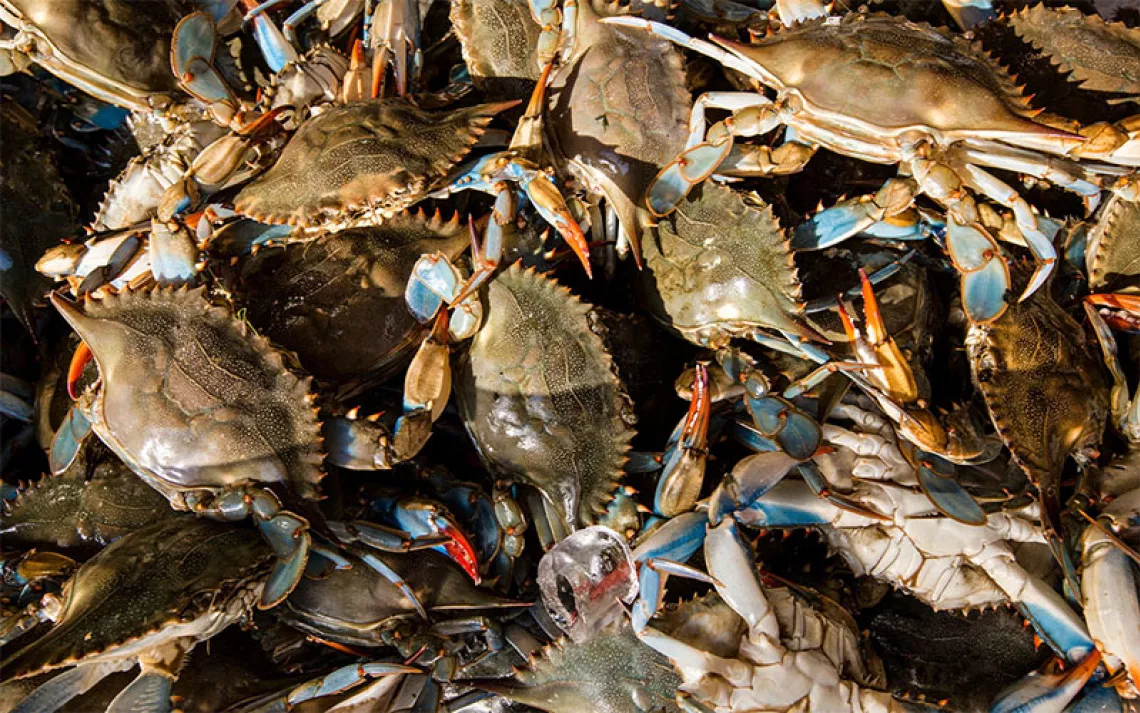Fungal Disease Poses Looming Threat to Salamanders
Ecologists try to stop it from reaching the Americas, home to more than half of all salamander species

A red salamander. | Photo by JasonOndreicka/iStock
The fungus Batrachochytrium dendrobatidis, or Bd, has contributed to dozens of extinctions of frog species worldwide and precipitated dramatic declines in hundreds more. So conservation biologists were understandably worried when a closely related fungus, Batrachochytrium salamandrivorans, or Bsal, was found killing salamanders in Europe in 2013. Over the past 10 years, scientists have scrambled to learn as much as possible about this fungus, with the aim to slow its spread and prevent further extinctions.
Deb Miller, a wildlife pathologist and director of the Center for Wildlife Health at the University of Tennessee, explains that Bsal causes disease in salamanders by infecting and damaging their skin. “The salamander skin is super important,” explains Miller. “It is not only a source of electrolyte balance and hydration, but it's also important for respiration.” If these critical functions are disrupted by a severe skin infection, it can trigger heart failure or other fatal conditions.
Not all salamanders are equally susceptible to getting infected with Bsal, or to developing symptoms or dying of the disease. Federico Castro Monzón, a herpetologist at the Universidad Nacional Autónoma de México, has been reviewing studies from the past decade to look for patterns in Bsal susceptibility among salamanders and document the pathogen’s current geographic range. Castro Monzón and his colleagues reported in a recent issue of EcoHealth that 64 salamander species and three frog species have tested positive for Bsal so far. Some of these infections were found during surveys of wild or captive animals, while others were from experiments in which the animals were exposed to the pathogen to test their susceptibility.
While a range of salamanders are capable of hosting Bsal, the species that have so far been observed dying from the disease have all belonged to two families: Salamandridae (newts) and Plethodontidae (lungless salamanders). The susceptibility of lungless salamanders is especially concerning because they are by far the largest salamander family, with just over 500 species out of around 800 total. And the vast majority of these species are found in the Americas, where Bsal has not yet spread—as far as anyone knows—but is likely to in the future.
Unlike frogs, salamanders are found primarily in the Northern Hemisphere, although there are a handful of South American species that live south of the equator. Partially due to the diversity of lungless salamanders, North and Central America contain more than half of the salamander species worldwide. The United States has more salamander species than any other country, with Mexico coming in second. And certain regions within North America, like the southern Appalachian Mountains, are even considered global hot spots for salamander biodiversity.
Castro Monzón says that Bsal is likely to be especially devastating to the many species that are already at risk of extinction due to having extremely small ranges. “Here in the Americas, we have some species that might disappear really fast,” he says. In their review, Castro Monzón and his colleagues reported that scientists have detected Bsal in wild animals in nine different countries throughout Europe and Asia, but so far, the pathogen has not been found in the Americas. However, field testing has been far from comprehensive. The researchers found reports of 15 Bsal field studies in the US, compared to only three in Mexico and two in Central America (one in Guatemala and one in Panama). Without increased testing across Mexico and Central America—regions with hundreds of salamander species—Castro Monzón worries that Bsal could arrive and start spreading undetected.
Within the US, the biggest policy action taken so far to limit the risk of Bsal introduction happened in 2016, when 201 salamanders were added to the list of “injurious species” in the Lacey Act, prohibiting their import into the country. This policy was passed remarkably quickly in response to the clear need for rapid action. However, soon after these species were added to the Lacey Act, new studies were published showing that other salamanders, and even some frogs, can carry Bsal too. These findings were especially concerning because certain frog species, like the American bullfrog, make up a huge proportion of the amphibian trade into the US.
“Legislation policy enacted that fast was amazing, and I think it had some really positive impacts,” says Evan Eskew, a conservation biologist with the Computational One Health team at the University of Idaho. But, he adds, “It was guided by the scientific information that was available at the time, which is primarily focused on salamanders.” Eskew argues that more research is needed on bullfrogs in particular to determine how likely they are to spread Bsal through current trade routes.
Scientists with the North American Bsal Task Force have been working to help landowners and policy-makers incorporate the latest Bsal research findings into their decision-making. And some task force members have been collaborating with the pet industry as well. Matt Gray, a disease ecologist at the University of Tennessee, is part of a team that is developing a healthy pet certification program. Their goal is to encourage companies that sell amphibians as pets to test all of their animals for infectious diseases like Bsal, Bd, and Ranavirus—another amphibian-infecting pathogen.
Gray thinks they can convince companies that certification and continued compliance with the program will be profitable in the long run. He has good reason to believe this too. A survey conducted by the team found that amphibian pet owners would be willing to pay 75 percent more for animals that have tested negative for Bd, Bsal, and Ranavirus. And pathogen infections currently cause massive financial losses to the pet industry. “We’ve estimated around the order of $100 million a year can be lost in revenue,” says Gray, “so it's not an insignificant amount that these pathogens are causing harm to the industry.”
According to Miller, there are medical treatments for Bsal that can be highly effective, especially in combination, but they are not perfect solutions. Since the fungus thrives in cool temperatures, raising a salamander’s body temperature above 77°F (25°C) can clear the infection. But some salamanders might not withstand even this modest heat treatment, plus the method is not always feasible on larger scales in the field. As for fungicides, Miller says, “Those are OK, but they can be toxic in and of themselves to amphibians.”
Molly Bletz, a disease ecologist at the University of Massachusetts Amherst, has been investigating whether probiotics could help protect salamanders as well. Beneficial skin microbes have long been a focus of attention for scientists studying Bd. “There's been work over the years for identifying Bd-inhibiting bacteria,” says Bletz. “We can basically just go back and look at those and say, 'OK, well, which of these also inhibit Bsal?'”
Bletz and her colleagues have also been considering boosting the natural populations of what she calls micropredators—tiny aquatic animals that eat the fungal zoospores. “Different zooplankton swim around and they chomp on the zoospores. And so they are removing the pathogen from the environment, which can then reduce the likelihood of infection,” says Bletz.
She hopes these lines of research as well as the broader efforts of the Bsal Task Force will help prevent disaster should Bsal reach the Americas. “We were sort of always running after Bd, and we didn't know what was happening until it was kind of too late,” says Bletz. By being proactive and taking the threat of Bsal seriously, the story may just turn out differently this time.
 The Magazine of The Sierra Club
The Magazine of The Sierra Club



